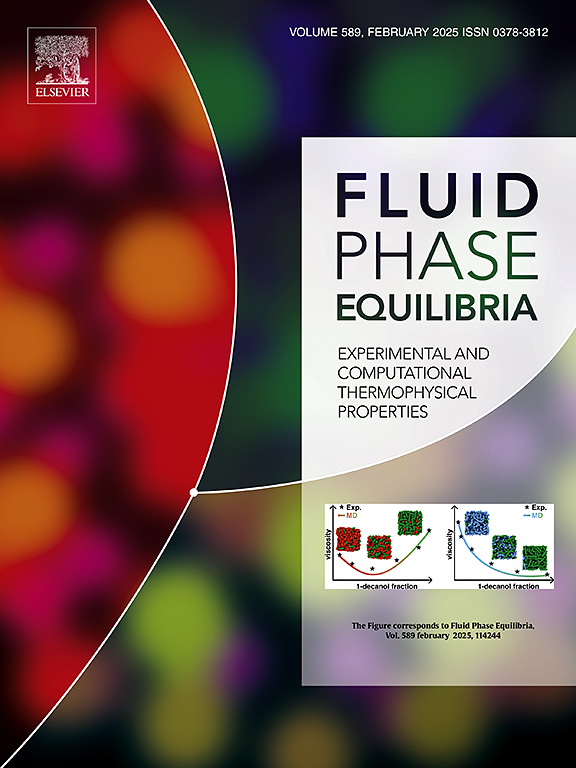使用核磁共振指纹和群体贡献状态方程的不良指定混合物的热力学建模
IF 2.7
3区 工程技术
Q3 CHEMISTRY, PHYSICAL
引用次数: 0
摘要
在化学和生物技术过程中,成分仅部分已知的混合物无处不在,这对过程设计和优化构成了重大挑战,因为经典热力学模型需要完全的物种形成,而在许多情况下,这是不可能通过合理的努力获得的。在之前的工作中,我们引入了一个结合标准核磁共振(NMR)实验和机器学习(ML)算法的框架,用于自动阐明未知混合物的基团组成和伪组分的合理定义,并将结果与吉布斯多余能量的基团贡献(GC)模型一起应用。在目前的工作中,我们将这种方法扩展到状态群贡献方程(GC-EOS)的应用中,从而能够对这种混合物的基本所有热力学性质进行预测建模。作为一个例子,我们讨论了SAFT-γ Mie GC-EOS在几种已知成分的测试混合物中预测CO2溶解度的应用。然而,在应用我们的方法时没有使用它们的成分信息;它仅用于与SAFT-γ Mie EOS生成参考结果,并将其与我们方法的预测进行比较。此外,还利用核磁共振光谱法测定了CO2在试验混合物中的溶解度。研究结果表明,该方法可以应用于GC-EOS,进一步扩展了其在工艺设计和优化中的适用性。本文章由计算机程序翻译,如有差异,请以英文原文为准。
Thermodynamic modeling of poorly specified mixtures using NMR fingerprinting and group-contribution equations of state
Mixtures of which the composition is only partially known are ubiquitous in chemical and biotechnological processes and pose a significant challenge for process design and optimization since classical thermodynamic models require complete speciation, which cannot be obtained with reasonable effort in many situations. In prior work, we have introduced a framework combining standard nuclear magnetic resonance (NMR) experiments and machine-learning (ML) algorithms for the automated elucidation of the group composition of unknown mixtures and the rational definition of pseudo-components and have applied the results together with group-contribution (GC) models of the Gibbs excess energy. In the present work, we extend this approach to the application of group-contribution equations of state (GC-EOS), enabling the predictive modeling of basically all thermodynamic properties of such mixtures. As an example, we discuss the application of the SAFT- Mie GC-EOS for predicting the CO solubility in several test mixtures of known composition. However, the information on their composition was not used in applying our method; it was only used to generate reference results with the SAFT- Mie EOS that were compared to the predictions from our method. In addition, the CO solubility in the test mixtures was also determined experimentally by NMR spectroscopy. The results demonstrate that the new approach for modeling poorly specified mixtures also works with GC-EOS, which further extends its applicability in process design and optimization.
求助全文
通过发布文献求助,成功后即可免费获取论文全文。
去求助
来源期刊

Fluid Phase Equilibria
工程技术-工程:化工
CiteScore
5.30
自引率
15.40%
发文量
223
审稿时长
53 days
期刊介绍:
Fluid Phase Equilibria publishes high-quality papers dealing with experimental, theoretical, and applied research related to equilibrium and transport properties of fluids, solids, and interfaces. Subjects of interest include physical/phase and chemical equilibria; equilibrium and nonequilibrium thermophysical properties; fundamental thermodynamic relations; and stability. The systems central to the journal include pure substances and mixtures of organic and inorganic materials, including polymers, biochemicals, and surfactants with sufficient characterization of composition and purity for the results to be reproduced. Alloys are of interest only when thermodynamic studies are included, purely material studies will not be considered. In all cases, authors are expected to provide physical or chemical interpretations of the results.
Experimental research can include measurements under all conditions of temperature, pressure, and composition, including critical and supercritical. Measurements are to be associated with systems and conditions of fundamental or applied interest, and may not be only a collection of routine data, such as physical property or solubility measurements at limited pressures and temperatures close to ambient, or surfactant studies focussed strictly on micellisation or micelle structure. Papers reporting common data must be accompanied by new physical insights and/or contemporary or new theory or techniques.
 求助内容:
求助内容: 应助结果提醒方式:
应助结果提醒方式:


